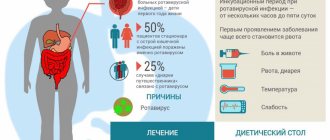Features of the virus
Human cytomegalovirus is a DNA virus from the herpesvirus family.
Other members of this family are the causative agents of herpes, chickenpox, mononucleosis and other diseases. CMV develops in connective tissue cells and often spreads throughout the body. Replication of viral particles occurs in leukocytes: the pathogen enters the cell, introduces its own genetic information into the nucleus and triggers the assembly of the necessary protein components. After replication, virions leave the affected cell and attack other leukocytes, affecting external receptors. The mechanism of transmission of the virus has not been thoroughly studied, but experts know that CMV can be present in almost all biological fluids, including saliva, semen, urine and blood. It is believed that the infection is most often transmitted through kissing and sexual contact. Due to its moderate contagiousness, infection requires close contact with a carrier of the virus.
In the external environment, the virus quickly loses its virulent properties, so the household route of transmission is not so common. CMV is easily inactivated by ethanol and exposure to high temperature. After entering the body, the virus is not destroyed by the immune system, however, lymphocytes are able to secrete immunoglobulins that remain in a person throughout life.
Transfer methods
For cytomegalovirus to invade the body, contact with an infected biological fluid is necessary. It is believed that the largest number of viral particles is contained in saliva, so the infection is most often transmitted through kissing. The airborne mechanism of transmission of the disease implies a risk of infection even when talking with a carrier of the virus, since saliva can enter the oral cavity.
Other infection options:
- Sexual transmission: The virus is transmitted through vaginal mucus, lubricant and semen.
- Transmission of the disease from mother to child through the placenta. Infection of a newborn is also possible during childbirth.
- Organ transplantation and blood transfusion.
The risk of intrauterine transmission of CMV increases if a woman first becomes infected with the infection during pregnancy. In children and adults, pathogen invasion can occur even with minor contact: a person touches their eyes and lips with dirty hands after contact with a carrier of the infection.
Gynecologist's recommendations for disease prevention
For infection to become possible, it is necessary to come into very close contact with an infected person.
Therefore, to prevent cytomegalovirus infection in women and protect against possible consequences, it is recommended to responsibly choose sexual partners, as well as donors in the case of blood transfusion or organ transplantation. Also, to prevent CMV, it is recommended to use personal dishes and cutlery - this requirement is especially important for people living in dormitories and communal apartments. Compliance with hygiene requirements is also extremely important. We are talking about timely washing of hands after contact with other people and objects, as well as maintaining intimate hygiene. For this purpose, you can use the Ginocomfort washing gel. Thanks to its balanced hypoallergenic composition, which includes tea tree oil, chamomile extract and other natural ingredients, this product delicately cleanses the intimate area and has an antimicrobial and moisturizing effect. Sources:
- ROLE OF CYTOMEGALOVIRUSES IN OBSTETRIC PATHOLOGY AND NEONATOLOGY. Smirnova A.I., Rossikhina E.V., Dyupina N.S. // Vyatka Medical Bulletin. – 2010. – P. 1-14.
- CYTOMEGALOVIRUS INFECTION. Lutsenko M. T. // Bulletin of physiology and pathology of breathing. – 2012. – No. 44. – pp. 131-136.
- CLINICAL VARIANTS AND CLASSIFICATION OF CYTOMEGALOVIRUS INFECTION IN YOUNG CHILDREN. Baranova I.P., Kerimova Zh.N., Konnova O.A., Lesina O.N., Nikolskaya M.V., Krasnova L.I. // 2009 – pp. 13-15.
- Human herpesvirus infections: a guide for doctors. Isakov, V.A., Arkhipova E.I., Isakov D.V. // SPb.: SpetsLit. - 2006. - P. 300.
- Viral infections of pregnant women: pathology of the fetus and newborns. Kitsak, V.Ya. // Inf.-met. allowance. Koltsovo. - 2005.- P.59-69.
- Modern therapy of herpesvirus infections: a guide for doctors. Isakov, V.A. // St. Petersburg. - 2004. - P. 168.
- https://www.omicsonline.org/open-access/cytomegalovirus-disease-in-patient-with-hiv-infection-antimi…
- https://www.medicinenet.com/cytomegalovirus_cmv/article.htm
- https://academic.oup.com/jid/article/215/10/1523/3738524
Pathogenesis
Once infected, CMV enters the bloodstream and spreads throughout the body. Initially, humoral immunity responds to infection with the formation of immunoglobulin M - this reaction is maintained for two months. Approximately six months after infection, immunocompetent cells secrete specific immunoglobulin G, which remains in the host’s body throughout life. Lymphocytes (CD8 and CD4) are also responsible for suppressing the activity of the virus. In patients with reduced immunity, CMV immediately begins to show its virulence.
Most healthy people infected with cytomegalovirus after birth have no symptoms. In rare cases, a clinical picture resembling infectious mononucleosis develops: a mild form of hepatitis, fever and sore throat. These pathological signs quickly pass, after which the virus does not manifest itself in any way until reactivation.
Regardless of the form of the disease, CMV affects the body's tissues. The so-called cytomegaly develops, characterized by a significant increase in cells. Such morphological changes can be explained by the destruction of the cytoskeleton and the active synthesis of viral particles that become cellular inclusions. During a histological examination of the affected tissue, a specialist can detect fibroblasts that resemble an owl's eye in appearance.
Risk group for developing active infection:
- newborns;
- aged people;
- patients with leukemia;
- HIV-infected;
- people with congenital immunodeficiency;
- patients with cancer;
- patients who require hemodialysis or immunosuppressants.
In HIV-infected patients, the manifestation of cytomegalovirus infection may indicate the development of acquired immunodeficiency syndrome (AIDS), since in this case the number of T-lymphocytes decreases.
Cytomegalovirus infection - symptoms and treatment
The incubation period is from 15 days to three months (with a manifest, i.e. clearly expressed form).
Congenital form of cytomegalovirus infection
Cytomegalovirus infection is detected in approximately one in 200 children born, every fifth of them has or will have health problems. Immediately after birth, low body weight, enlarged liver and spleen, jaundice, enlargement of all groups of lymph nodes, hemorrhagic rashes, various organ lesions, sudden changes in hemogram and functional tests are detected. Viral DNA is detected in blood, saliva and urine (in some cases, virus isolation continues for several years).
The prognosis is serious and depends on the severity of the lesion and the volume of treatment measures taken. At later stages of infection in a pregnant woman, the likelihood of severe manifestations of the disease is significantly lower, and newborns, as a rule, do not have symptoms of congenital CMV infection in the initial stages after birth, but this does not indicate complete clinical well-being in the future - damage to the nervous system of varying degrees of severity is possible and sensorineural hearing loss. Therefore, such children need examination and observation by specialized specialists, and, if necessary, treatment.[1][2][3][5][8][10]
Acquired form of cytomegalovirus infection
In acquired forms, the disease most often occurs in childhood or adolescence. During these periods, the greatest lability of the immune system is observed (important in the group of “childhood infections”).
Most often, primary infection occurs either asymptomatically or as a mild acute respiratory infection. Slight weakness, low-grade fever (temperature 37.1-38.0°C), muscle discomfort, sore throat, sometimes runny nose, enlarged lymph nodes in the neck, enlarged and sore salivary glands are observed.
Often, such manifestations do not raise suspicions about CMV and resolve on their own within 1-2 weeks—the disease enters the latent stage (carriage).
When infected at a later age (adults), as well as in some children (with impaired immunity) and weakened patients, the disease, as a rule, occurs with obvious morphofunctional disorders and is much more severe than in the first group of people. Observed:
- prolonged fever with an increase in body temperature to febrile levels (37.5-38.0 ° C);
- severe weakness, malaise, headaches;
- discomfort and pain in the abdomen in the area of the right and left hypochondrium;
- enlargement and soreness of the salivary glands;
- enlargement and sensitivity of the cervical and maxillary lymph nodes;
Tonsillitis syndrome is not typical. The liver and spleen enlarge, the hemogram and liver function tests significantly change.
Depending on the state of the immune system and the possibilities of its correction, a clinically significant primary infection in this group of people lasts for 1-3 months and, as a rule, ends with the body’s victory over viral expansion with the subsequent formation of virus carriage without any obvious clinical manifestations.
In some cases (HIV infection, cancer, long-term use of cytostatic drugs, genetic defects of the immune system), a long wave-like course of the primary infection or reactivation (exacerbation) of the existing carriage of the virus (latent form) may be observed. In this case it is noted:
- prolonged undulating fever with an increase in body temperature from subfebrile to febrile levels;
- general malaise;
- more often generalized enlargement of all groups of lymph nodes;
- a wide range of organ pathology (based on the pantropism of the virus and individual characteristics) in the form of single or more often combined damage to the salivary glands (sialoadenitis), cytomegalovirus hepatitis, eye damage, pneumonia, damage to the genital organs, esophagus, intestines, heart;
- enlarged liver and spleen, increased ALT and AST, changes in peripheral blood of a viral nature (almost always).
Mononucleosis-like syndrome
In a severe form of the disease, a mononucleosis-like syndrome may develop - weakness, low-grade fever (37.1-38.0 °C), enlarged and sensitive lymph nodes, enlarged liver and spleen, and viral blood changes.
Symptoms of cytomegalovirus in men and women
Cytomegalovirus infection affects people of all ages and genders. There are no fundamental differences in symptoms between men and women, with the exception of damage to the genital organs.
Cytomegalovirus infection in pregnant women
In pregnant women, primary infection may be asymptomatic or with limited clinical manifestations (most often). When a child (fetus) is infected before birth, depending on the timing of the woman’s primary infection (sometimes true reactivation of CMV in AIDS), congenital cytomegalovirus infection may develop.
The risk of intrauterine transmission is up to 90% of all cases of infection at any stage of pregnancy.
If infected in the early stages of pregnancy, there is a high risk of spontaneous miscarriage, stillbirth or the birth of children with obvious developmental defects (pathologies of the lungs, brain, kidneys, heart, blood vessels, hearing organs, psychoneurological disorders).
An interesting feature is the influence of the age of the pregnant woman at which the primary infection occurred on the frequency of transmission of the infection: in women under 20 years of age, the risk of transmission is three times higher and does not depend on the timing of pregnancy, and after 20 years of age the risk of intrauterine infection is significantly lower
Symptoms of chronic cytomegalovirus infection
The disease becomes chronic if the virus remains in the body for a long time and the immune system cannot resist it. Characterized by prolonged low-grade fever (37.1-38.0 °C) and weakness. The liver, lymph nodes (usually several different groups), and sometimes the spleen may enlarge, eye damage and myocarditis may occur.
Cytomegalovirus infection in people with normal immunity
The disease is universal in nature and most often is not accompanied by any significant deviations in human life, i.e. The immune system of the average inhabitant of the planet is capable of independently finding a decent way out of the situation.
Cytomegalovirus infection in AIDS
With AIDS, the disease is extremely difficult - a generalized form of infection can develop, that is, various organs are affected:
- brain (meningitis, encephalitis with encephalopathy and dementia);
- eyes (retinitis, necrosis of the retina and optic nerve - leads to complete blindness);
- mucous membranes of the mouth, esophagus, intestines;
- lungs (pneumonitis, pneumonia);
- liver (hepatitis);
- kidneys (nephritis with tissue necrosis, renal failure);
- adrenal glands;
- heart;
- spleen, etc.
The prognosis is often unfavorable. A generalized form of cytomegalovirus infection can also develop in immunocompromised patients and infants.
Immunodeficiency disease
Cytomegalovirus infection manifests itself symptomatically in most HIV-infected people. The virus can infect the brain, lungs, liver, heart, bone marrow, genitals and other anatomical structures. The first stages of the pathology are characterized by the appearance of night sweats, fever, insomnia and muscle pain.
Forms of organ damage
- Pneumonia is inflammation of the lung tissue. In this case, the virus is detected not only in the lung parenchyma, but also in the bronchoalveolar fluid. In immunocompromised patients, this pathology can lead to death.
- Hepatitis is an inflammation of the liver tissue. Manifested by an increase in the level of bilirubin and hepatocellular enzymes. In rare cases, jaundice develops.
- Inflammation of the gastrointestinal tract. Doctors include diarrhea, abdominal pain and the formation of ulcerations in the mucous membranes as features of this complication.
- Inflammatory process in the retina of the eye. There is a progressive decrease in visual acuity. Irreversible blindness often develops.
- Nephropathy, manifested by impaired renal function.
Other dangerous complications of the disease include damage to the central nervous system and increased bleeding.
Congenital form
In most cases, intrauterine infection of a child does not lead to the development of symptoms. If a pregnant woman encounters cytomegalovirus invasion for the first time, the risk of developing a congenital disease in the newborn increases.
Signs and complications of congenital infection:
- Liver damage, manifested by organ enlargement, jaundice and increased bleeding.
- Intrauterine growth retardation and prematurity.
- Microcephaly and retinitis.
- Enlarged spleen.
The probability of death from congenital infection reaches 30%. The negative consequences of cytomegalovirus infection subsequently become the cause of human intellectual disability.
Diagnostics
The necessary examinations can be completed by an infectious disease specialist. The doctor will ask the patient about complaints, carefully review the medical history to identify risk factors, and conduct a general examination. An active infection in immunocompetent people is manifested by symptoms of mononucleosis, so to clarify the diagnosis, a specialist will need the results of laboratory and instrumental studies.
Prescribed diagnostic procedures:
- Blood test for immunoglobulins. In the first weeks after infection, IgM antibodies are detected in patients. Also, the presence of these antibodies may indicate an exacerbation of a chronic disease. A high concentration of IgM in a pregnant woman indicates a risk of damage to the fetus. If the patient has IgG antibodies, the doctor suspects viral carriage without clinical manifestations.
- Polymerase chain reaction - detection of viral DNA in biological fluids and patient tissues. An assessment of the number of viral particles allows us to draw a conclusion about the severity of the pathology.
- Examination of organs for active infection. The doctor prescribes visual diagnostics and additional tests, such as a biochemical blood test to detect liver failure.
If primary CMV infection is detected in the body, it is recommended to undergo screening for HIV infection to exclude complications. Also, patients at risk necessarily require regular monitoring.
Diagnosis of CMV infection
Diagnosis of herpesvirus (HSV and CMV) infections:
- The diagnosis of HSV and CMV infections can be made (especially in asymptomatic, atypical and latent forms of herpes) only on the basis of detecting the virus in biological fluids of the body (blood, urine, saliva, genital tract secretions) using the PCR method or with special culture of cells. PCR answers the question: the virus is detected or not, but does not answer the activity of the virus.
- Sowing a cell culture not only detects the virus, but also provides information about its activity (aggressiveness). Analysis of culture results during treatment allows us to draw a conclusion about the effectiveness of the therapy.
- IgM antibodies may indicate either a primary infection or an exacerbation of a chronic infection.
- IgG antibodies only indicate that a person has encountered the virus and an infection has occurred. IgG in herpesvirus infections persists for life (unlike, for example, chlamydia). There are situations in which IgG has diagnostic value.
Read more about taking tests to diagnose CMV infection.
Treatment
Drug treatment of infection involves the use of various antiviral agents. Clinical guidelines instruct physicians to prescribe cytomegalovirus immunoglobulin, ganciclovir, foscarnet, or cidofovir to patients. The specific treatment regimen depends on the symptoms of the disease and the patient’s condition.
Description of drugs
- Cytomegalovirus immunoglobulin is a specific class G antibody that can fight the virus. The drug blocks the ability of the virus to influence cell signaling systems and stimulate the assembly of virions. This medicine is used as primary therapy in combination with other antiviral medicines or prescribed to prevent the disease. The use of immunoglobulin can significantly reduce the risk of complications of the disease.
- Ganciclovir, foscarnet and other drugs block viral replication. Side effects of these drugs include increased bleeding, kidney damage, and gastrointestinal dysfunction. In case of renal failure, such medications are used as a last resort.
Timely implementation of prevention allows you to suppress the infectious process and gives the patient the opportunity to avoid taking dangerous drugs.
Popular questions
Good afternoon.
I'm planning a pregnancy. Help Decipher the results of the analysis for cytomegalovirus. 1) CMV IgG - >500 U/ml, normal <0.5, 0.5-1.0 gray zone, 2) CMV IgM 0.42, normal <0.7, 0.7-0.1 gray zone, 3) CMV IgG Avidity-78.6%, normal <45.0 Avi %, 45.0-54.9 Avi % gray zone. Hello Nina! The presence of IgG and a high avidity index indicates that you have had a cytomegalovirus infection in the past and are now seropositive for this virus. The prognosis for future pregnancy is most favorable.
Hello! Pregnancy 26-27 weeks. Complaints of itching in the genital area, a cheesy discharge, I put the candibene suppositories on, disappeared and reappeared again. I’m afraid to put the suppositories back, is it possible to wash off with a furacillin solution?
Hello, Gulmira! Recurrent candidiasis is a fairly common problem during pregnancy, requiring several courses of antifungal drugs, followed by the prescription of agents that help maintain normocenosis (Ginocomfort restorative gel with tea tree oil). There is no need to wash yourself with furatsilin solution; for daily intimate hygiene, use special products with an acidic (physiological) pH level and a soft detergent base, preferably containing natural ingredients - such products do not irritate and gently cleanse the mucous membrane, the optimal one among these products is “ Ginocomfort" washing gel.
Hello. I was tested for infections. Found: chlamydia trachomatis, biovar u.urealyticum T960, biovar ureaplasma parvum, gardnerella vaginalis, HPV 16 genotype. I paid 3,500 rubles for the first appointment. In order to prescribe treatment, you need to pay again for the appointment, about 2000. There is no opportunity to go to the appointment again. Please advise some treatment. Thanks in advance.
Hello! You need to see a doctor again to prescribe treatment, because when drawing up a regimen and stages of therapy, not only test results are taken into account, but also examination data assessing complaints, prevalence and duration of the disease.
Hello! I have a genital tract infection, can it be treated and how?
Hello!
First of all, you need to see a doctor and conduct an examination to identify the infectious factor. This will allow you to correctly prescribe the main therapy. In addition, to improve and consolidate the effect of treatment, it will be possible to add Gynocomfort gel with tea tree oil to the regimen, 1 dose once a day for 7-10 days. For an accurate diagnosis, contact a specialist
Prognosis and prevention
In immunocompetent people, carriage of the virus does not affect the quality of life. Only a few studies indicate the risk of developing atherosclerosis with long-term persistence of CMV in the body. The prognosis for immunodeficiency depends on the clinical manifestations of the disease and the timeliness of treatment. The highest mortality rate is characterized by cytomegalovirus pneumonia.
Prevention methods:
- compliance with personal hygiene rules (You must wash your hands regularly);
- separate meals with the child;
- regular cleaning of any objects that have come into contact with the child’s urine or saliva (This is especially true for toys);
- using a condom;
- regular examinations for HIV positive status and other conditions that negatively affect immunity.
- drug prevention of infection during organ transplantation and use of immunosuppressants.
Thus, cytomegalovirus infection is a viral disease that can affect human organs and tissues when the immune system is impaired. First of all, this pathology is dangerous for pregnant women and children, so screening for CMV must be carried out in advance.
Treatment of cytomegalovirus: medications used in therapy
To date, there is no single treatment method or “pill” with which the virus is completely eliminated from the body. Scientists have not yet invented a cure for cytomegalovirus that would permanently get rid of the disease. But today there are already antiviral drugs, the use of which helps relieve symptoms of the disease and improve well-being.
Since an important link in the activation and spread of this infection in the patient’s body is a decrease in immune defense, drugs containing interferons are used to maintain immunity at the required level. One of these drugs is the broad-spectrum complex antiviral immunomodulatory drug VIFERON for children and adults. It has a double effect - it helps block the virus and restore immunity. The original formula of the drug includes a combination of interferon alpha-2b and highly active antioxidants (vitamins C, E). The drug belongs to the group of cytokines and has a universal effect in the treatment of a wide range of viruses and other pathogens.
VIFERON Suppositories for cytomegalovirus
VIFERON in the form of suppositories (suppositories) for the treatment of cytomegalovirus in adults can be used during pregnancy (from the 14th week), as well as during breastfeeding. The drug is also approved for children, including newborns and premature babies. VIFERON helps reduce the frequency of relapses1 and is used as part of complex therapy to combat a number of diseases, including infectious and inflammatory diseases of the urogenital tract in adults (human papillomavirus, chlamydia, cytomegalovirus infection, ureaplasmosis, trichomoniasis, gardnerellosis, bacterial vaginosis, recurrent vaginal candidiasis , mycoplasmosis).








